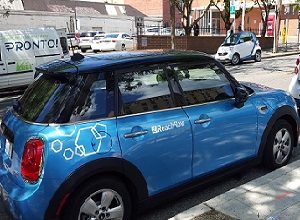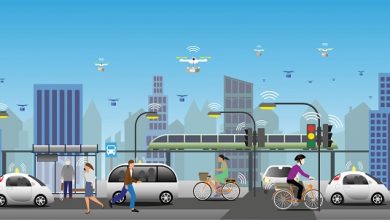SMART mobility to define the New Normal!

India is reeling under the clutches of Covid-19 pandemic and the automotive industry has been one of the hardest hit with shrinking sales. The shared mobility sector which had been the sunshine sector in the recent years churning out a number of invested startups like Bounce, Vogo, Dunzo etc. have been grappling with cash leading to layoffs. Some have gone ahead and started selling their fleet vehicles to generate the much needed cash! As much as this paints a grim picture of the shared mobility sector, not all is lost and there are “new & emergent ideas” that can and have already started to define the new normal in the post Covid world. However this necessitates #FutureOfMobility defined by Connected, Autonomous, Shared and Electric (CASE) to embrace SMART in each aspect of its definition. Most firms working in technologies related to CASE find the shared mobility sector as the lowest hanging fruit for technology adoption as it has a direct relevance to increasing operational efficiencies.
Shared mobility is broadly categorized under – ride hailing & ride sharing. Home grown ride hailing unicorn Ola is the market leader under ride hailing whereas ride sharing can be further categorized into bike sharing popularised by Bounce and car sharing by ZoomCar, Revv [Self-drive] and Quickride, BlaBlaCar [Car Pooling]. Millennials have binged on ride sharing platforms given their limited affinity towards owning assets but rather on utilizing shared assets for point to point intra-city mobility. No wonder this space is teeming with startups with millennials at the helm of affairs! Lastly there is shared mobility for last mile delivery – extremely relevant today & in the near future due the pandemic. One can see the two wheeler fleets of Bounce & Vogo being efficiently cross utilized for last mile delivery for eCommerce and food delivery. Increasingly these firms and many others have been trying to electrify their fleets and importantly for the right reasons! Let’s investigate further!
The fundamental requirement for being SMART is to go digital or electric in mobility terms. Electric vehicles are a default choice for faster & wider adoption of telematics. It is not just about the ease of integration of telematics systems on EVs but also the lower complexity and costs when compared to an ICE (Internal Combustion Engine) vehicle. What is the measure of disruption here? Advanced vehicle functionality data which were available only on high end luxury cars are now made available on electric two wheelers at one tenths of the cost. Companies like Ather are revolutionizing the consumption of two wheelers leveraging the data available on telematic systems. This brings in a tremendous dimension of providing access to contemporary/leading innovations to everyone! Including the lower most economic strata of our society thereby allowing a large chunk of our population to benefit from the technology!
In EVs all pertinent data, core to the functionality of the vehicle are available on the CAN Bus and CAN Data loggers with GPS and GPRS/ 4G LTE can be used to upload the data real time on private clouds for computing. It is important to note that key EV components like motor, controller & batteries have the requisite sensors built in like speed, temperature, position & voltage sensors. These enable continuous, realtime and online monitoring of performance as well as health parameters centrally. This amalgamation of electric mobility and telematics can be termed as “SMART mobility” which is referred interchangeably as ‘Advanced Telematics’ here.
What does this mean to an end user of SMART mobility? What does this mean to a Fleet Operator or a company involved in logistics or last mile delivery? How can each of these stakeholders benefit by using ‘Advanced Telematics’ in their business operations. Let us delve deeper!
Who is the end user of an Advanced Telematic system and how does he/she benefit?
Fleet Operator/Delivery Company
The prominent end user who can benefit from an Advanced Telematics system is the Fleet Operator or a Last-mile Delivery Company. Fuel pilferaging is one of the most common problems faced by Fleet Operators. Fuel cost & driver salary form the largest chunk of their working capital requirement. A SMART Electric Vehicle with telematics built in is a natural right fit here since fuel is the electric charge! The smart systems can log minute by minute data of the electric charge being consumed for charging the batteries thereby providing the exact cost of charge or fuel to the Fleet Operator.
Another interesting dimension from the adoption of SMART electric vehicles, is that Fleet Operators or Last-mile Delivery Companies are able to project their variable costs much more accurately. This is because International Oil prices fluctuate more than the Electricity Tariffs within the country. Adding to this is the rupee dollar currency variation which has a significant bearing on the oil price for consumers in India. Companies are hence able to arrive at better estimates of their 3 to 5 year business projections by having fixed or stable operating costs providing the much needed clarity for investment decisions by their boards.
The third aspect is on the driver’s riding pattern and on road behaviour which can be easily monitored by Fleet Operators to validate he/she is adhering to the safety protocols – speed limits, lane changing etc that indicate rash driving. There are means to remotely control speed limits or lock vehicles in situations of over abuse. Lastly, the GPS system enables Last-mile Delivery Companies to track riders adhering to optimized delivery route plans shared to help improve the On-time delivery (OTD) metrics agreed with the customer.
The battery discharge rate is a great proxy for building analytical models of riding behavior and developing mechanisms to improve. In all, these provide for the critical metrics required by a Fleet Operator or Last-mile Delivery Company operating in the shared mobility ecosystem to maximize efficiency, reduce delivery lead times and fuel expenses. The “new normal” specifically calls for preserving cash being critical for survival.
The other end-user is the rider or driver himself
Drivers/riders form the second set of stakeholders who benefit from Advanced Telematics. Here is a great example, warranting a specific mention of Sun Mobility, their Smart batteries come built in with all these Advanced Telematics. These swappable batteries are interoperable on two wheelers and three wheelers. Sun Mobility also provides a rider App where every rider can access real time information such as “State of Charge (SOC)” and “Distance to Empty (DTE)” thereby gathering real time information on how many kilometers they can drive as of that moment and location. In parallel, the app also suggests the nearest swap stations and their locations for swapping discharged batteries along with the navigation support using Google Maps API. These metrics provide much needed confidence to the driver assuaging the fears of range anxiety. This is another solid example of how tech based EV companies are leveraging Advanced Telematics and building their business models around them.
What more can Advanced Telematics offer?
As we drill down the cost of delivery to the last atom, we see new areas where Advanced Telematics can play a key role. One such area is “Arbitrage of shared space!” eCommerce firms and Grocery Retail firms such as Amazon, BigBasket, etc. are flourishing by the day. Operational effectiveness is the key to lowering delivery costs to the firms as well as what they load to the end consumers. We seldom see last mile delivery vehicles – two wheelers and 4 wheeled pickup trucks being used sub optimally in terms utilizing the volumetric space available for the delivery run. Shared space arbitrage takes into consideration key parameters such as route plan, space requirement & agreed delivery timelines for each package and provides the right vehicle & route for delivering the package. This means a small package can be delivered in a big truck and vice versa based on the right fit!
This calls for a paradigm shift in the way Last-mile Delivery Companies can charge eCommerce firms basis the volumetric space utilized irrespective of whether it was delivered in a two wheeler or a three wheeler or a four wheeler i.e. being agnostic to a vehicle platform. This concept shares glimpses of how “Mobility as a service” can be best served by means of Advanced Telematics – which in this case calls for sensors that can measure volumetric space available in real time for route planners to allocate vehicles.
What lies in the future!
One aspect of #Futureofmobility we typically give a miss in contemporary dialogues is “Autonomous Vehicles”. Commercialization of 2D/3D Lidars and high end automotive cameras has provided the much needed fillip for scaling up of commercially viable Autonomous solutions.
What is the play for Advanced Telematics here?
Vehicle manufacturers (OEMs) typically specify the measures for achieving longer vehicle life, lower maintenance cost and overall lower total cost of ownership. People however, rarely adhere to these measures by abusing vehicle speed limits, harsh acceleration & braking, not following regular maintenance or service schedules etc. thereby mismanaging their assets. An autonomous vehicle’s performance can be tailored to the specifications set by the OEM to extract the best possible utility thereby reducing the total cost of ownership for a person or entity.
Summing up!
We have looked at quite a few areas in the Shared Mobility ecosystem that can benefit from the tremendous potential of Advanced Telematics; starting from reducing the operating costs for Fleet Operators, increasing the productivity of drivers/ riders to Space optimization for Last-mile Delivery. With the World moving towards reaping the benefits of Advanced Telematics driven Shared Mobility ecosystem, it’s time for India to take up the reins and steer through this disruptive concept. India & Indians make a strong case for adopting SMART!
Indians in the last decade have illustrated to the world their adeptness in embracing new technologies and innovations. India has generated a number of unicorns in eCommerce, ride-sharing, fintech and edutech sectors besides others. India being one amongst the top 5 automotive markets in the world has the requisite capabilities, investments & resources to be a great breeding ground for the development & manufacturing of Advanced Telematics and allied components & sub-assemblies that define SMART systems. The opportunity provided by the pandemic with strong sentiments towards localization and Government’s push towards a self-reliant or “Atmanirbhar” India calls for reinventing ourselves individually as well as a community. I strongly believe we can lead the world in SMART mobility by leveraging our domestic demand and frugal “price sensitive” innovations!
About the Author:
Gautam works as Executive Assistant to Chairman, Maini Group. He works on various new and Strategic initiatives within the Group. He leads the Business Development & Strategy for Virya Mobility 5.0 a new EV Startup under Maini Group focussing on Vehicle Integration, Powertrain Development & Charging Solutions.
Gautam is passionate about EVs and is keen to do his bit for the transformation of India mobility ecosystem. He has over 10 years of experience spanning across Software Development, Consulting, Strategy Planning & Business Development.
Published in Telematics Wire



